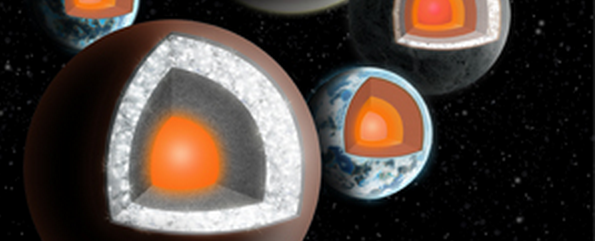Diamond planets more common than thought

Carbon-rich planets may be more common than previously thought, according to a new research by Yale University astronomers.
Some of these planets, all located far beyond Earth's solar system, could contain vast deposits of graphite or diamonds, and their apparent abundance prompts new questions about the implications of carbon-intense environments for climate, plate tectonics, and other geological processes, as well as for life.
"Despite the relatively small amount of carbon on Earth, carbon has been critical for the emergence of life and the regulation of our climate through the carbon-silicate cycle," said Yale doctoral candidate John Moriarty, who led the research, recently published in Astrophysical Journal. "It's an open question as to how carbon-rich chemistry will affect the habitability of exoplanets. We hope our findings will spark interest in research to help answer these questions."
Moriarty collaborated with Yale astronomy professor Debra Fischer and Nikku Madhusudhan, a former Yale postdoctoral researcher now at Cambridge University.
"Our study shows that extraterrestrial worlds can be extremely diverse in their chemical compositions, including many that are drastically different from our earthly experience," Nikku Madhusudhan.
Moriarty, Madhusudhan, and Fischer developed an advanced model for estimating exoplanet composition. Previous models were based on static snapshots of the gaseous pools (or disks) in which planets form. Their new model tracks changes in the composition of the disk as it ages.
The researchers found that, in disks with carbon-oxygen ratios greater than 0.8, carbon-rich planets can form farther from the center of the disk than previously understood. They also found that carbon-rich planets can form in disks with a carbon-oxygen ratio as low as 0.65 if those planets form close to their host star.
Previous models predicted carbon-rich planets could only form in disks with carbon-oxygen ratios higher than 0.8. This is important, the researchers said, because there are many more stars with carbon-oxygen ratios greater than 0.65 than there are with carbon-oxygen ratios greater than 0.8.
Astronomers generally believe that rocky exoplanets are composed – as Earth is – largely of iron, oxygen, magnesium, and silicon, with only a small fraction of carbon. In contrast, carbon-rich planets could have between a small percentage and three-quarters of their mass in carbon. (Earth has 0.005%.)
The paper, published May 6, is titled "Chemistry in an evolving protoplanetary disk: Effects on terrestrial planet composition."
Featured image and source: Yale. Illustration by Haven Giguere

Commenting rules and guidelines
We value the thoughts and opinions of our readers and welcome healthy discussions on our website. In order to maintain a respectful and positive community, we ask that all commenters follow these rules:
We reserve the right to remove any comments that violate these rules. By commenting on our website, you agree to abide by these guidelines. Thank you for helping to create a positive and welcoming environment for all.